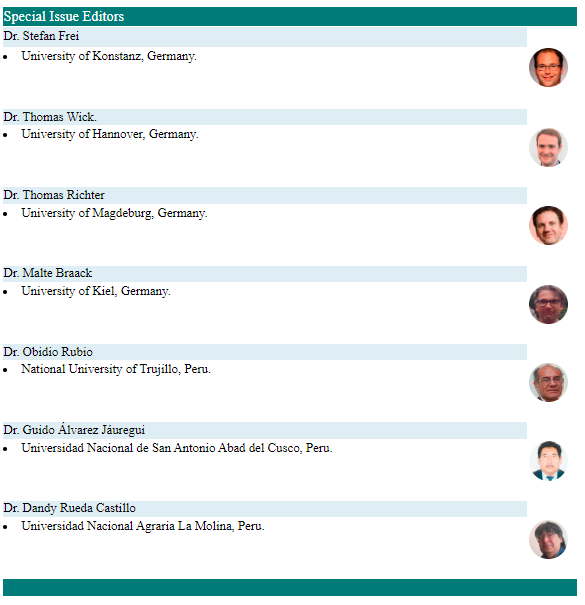Asignación de energía hacia funciones del ciclo de vida: Vínculo entre los niveles individual y poblacional
DOI:
https://doi.org/10.17268/sel.mat.2025.01.11Palabras clave:
Historia de vida, asignación de energía, modelo discreto, control óptimoResumen
La dinámica poblacional de los organismos está fuertemente influenciada por estrategias de vida que resultan de la asignación óptima de energía a funciones vitales como el crecimiento, la reproducción y la supervivencia. Estas estrategias, caracterizadas por rasgos fenotípicos, emergen como adaptaciones evolutivas ante condiciones ecológicas particulares y definen compensaciones funcionales relevantes frente a presiones bióticas y abióticas. El objetivo de este trabajo es examinar el vínculo entre historia de vida y dinámica poblacional desde una perspectiva bioenergética, articulando procesos individuales y poblacionales a través de modelos matemáticos que capturan decisiones adaptativas en entornos simulados descritos en términos de la disponibilidad de recurso constante, decreciente y periódico a lo largo del tiempo. Mediante un modelo matemático en tiempo discreto, que considera dos estados dados por la energía interna del organismo y su probabilidad de supervivencia, se incorpora la asignación energética hacia la reproducción y la búsqueda de alimento, con el propósito de determinar la estrategia óptima que maximice la tasa reproductiva neta. Para resolver este problema de control, se aplica el Principio Máximo de Pontryagin, empleando el método forward–backward, obteniéndose trayectorias óptimas de asignación, energía y supervivencia. Tales trayectorias se analizan en función de parámetros fisiológicos relevantes bajo distintos escenarios de disponibilidad de recursos, permitiendo así explorar el efecto de condiciones ambientales sobre las decisiones bioenergéticas de los organismos.
Citas
Stearns SC. The Evolution of Life Histories. Annual Review of Ecology and Systematics. 1992;23:1-29.
Partridge L, et al. The ecological context of life history evolution. Science. 1988;241(4872):1449-55.
Stearns SC. Life history evolution: successes, limitations, and prospects. Naturwissenschaften. 2000;87(11):476-86.
Stearns SC. Trade-offs in life-history evolution. Functional Ecology. 1989;3(3):259-68.
Stearns SC. The evolution of life history traits: A critique of the theory and a review of the data. Annual Review of Ecology and Systematics. 1977;8:145-71.
Caswell H. Life Table Response Experiments: Analyses of Effects on Population Growth Rate. Ecological Monographs. 1989;59(4):479-514.
Carey JR. Applied Demography for Biologists:With Special Emphasis on Insects. Annual Review of Entomology. 1993;38:39-52.
Caswell H. Sensitivity analysis of age-structured population models. Ecology. 1996;77(3):713-23.
Caswell H. Analysis of life table response experiments. I. Decomposition of effects on population growth rate. Ecological Modelling. 1989;46:221-37.
Belov M. Optimal control of the life cycle of complex systems. Control sciences. 2022;(1):15-26.
Akhmetzhanov AR, Grognard F, Mailleret L. Optimal life history strategies in seasonal consumer-resource dynamics. Evolution. 2011;65:113-3125.
Kozłowski J, Wiegert RG. Optimal allocation of energy to growth and reproduction. Theoretical Population Biology. 1986;29:16-37.
Ziółko M, Kozłowski J. Evolution of body size: an optimization model. Mathematical Biosciences. 1983;64:127-43.
Kozlowski J. Optimal allocation of resources to growth and reproduction: Implications for age and size at maturity. Trends in Ecology & Evolution. 1992;7:15-9.
Engen S, Saether BE. Optimal Allocation of Resources to Growth and Reproduction. Theoretical Population Biology. 1994;46:232-48.
Heino, Kaitala. Evolution of resource allocation between growth and reproduction in animals with indeterminate growth. Journal of Evolutionary Biology. 1999;12:423-9.
Perrin N, Sibly R. Dynamic Models of Energy Allocation and Investment. Annual Review of Ecology and Systematicsn. 1993;24:379-410.
Fischer B, Taborsky B, Dieckmann U. Unexpected Patterns of Plastic Energy Allocation in Stochastic Environments. The American Naturalist. 2009;173:108-20.
Fischer B, Dieckmann U, Taborsky B. When to store energy in a stochastic environment. Evolution. 2010;65:1221-32.
Mailleret L, Lemesle V. A note on semi-discrete modelling in the life sciences. Philosophical Transactions of the Royal Society A: Mathematical, Physical and Engineering Sciences. 2009;367:4779-99.
Cordova-Lepe F, Robledo G, Cabrera-Villegas J. Population growth modeling with boom and bust patterns: the impulsive differential equation formalism. Journal of Biological Systems. 2015;23(supp01):S135-49.
Gutiérrez R, Córdova-Lepe F, Moreno-Gómez FN, Velásquez NA. Persistence and size of seasonal populations on a consumer-resource relationship depends on the allocation strategy toward life-history functions. Scientific Reports. 2020;10:21401.
Gutiérrez R, Córdova-Lepe F, Moreno-Gómez FN, Velásquez NA. Plastic energy allocation toward life-history functions in a consumer-resource interaction. Journal of mathematical biology. 2022;85:68.
Chevin LM, Hoffmann AA. Evolution of phenotypic plasticity in extreme environments. Philosophical Transactions of the Royal Society B: Biological Sciences. 2017;372:20160138.
Fox RJ, Donelson JM, Schunter C, Ravasi T, Gaitán-Espitia JD. Beyond buying time: the role of plasticity in phenotypic adaptation to rapid environmental change. Philosophical Transactions of the Royal Society B:Biological Sciences. 2019;374:20180174.
Van Noordwijk AJ, de Jong G. Acquisition and Allocation of Resources: Their Influence on Variation in Life History Tactics. The American Naturalist. 1986;128(1):137–142.
Ng'oma E, Perinchery AM, King EG. How to get the most bang for your buck: the evolution and physiology of nutrition-dependent resource allocation strategies. Proceedings of the Royal Society B: Biological Sciences. 2017;284(1857):20170445.
Boggs C. Resource Allocation: Exploring Connections between Foraging and Life History. Functional Ecology. 1992;6:508-18.
Reznick D. Measuring the costs of reproduction. Trends in Ecology & Evolution. 1992;7:42-5.
Elaydi S. An Introduction to Difference Equations. 3rd ed. Undergraduate texts in mathematics. Springer; 2005.
Flatt T, Heyland A. Mechanisms of life history evolution: the genetics and physiology of life history traits and trade-offs. Oxford university press; 2011.
Kot M. Elements of Mathematical Ecology. 1st ed. Cambridge University Press; 2001.
Fisher RA. The genetical theory of natural selection: a complete variorum edition. Oxford University Press; 1999.
Smith TM, Smith RL. Elements of ecology. Pearson Higher Ed; 2012.
Dabbs K. Optimal control in discrete pest control models [Thesis]. University of Tennessee; 2010.
Dolezal J. Existence of optimal solutions in general discrete systems. Kybernetika. 1975;11(4):301-12.
Lenhart S, Workman JT. Optimal Control Applied to Biological Models. 1st ed. Chapman and Hall/CRC; 2007.
Lewis FL, Xie L, Popa D. Optimal and robust estimation: with an introduction to stochastic control theory. CRC press; 2017.
Altamirano-Fernández A, Rojas-Palma A, Espinoza-Meza S. Optimal rotation age in fast growing plantations: a dynamical optimization problem. Bulletin of Mathematical Biology. 2024;86(5):51.
Pianka ER. On r-and K-selection. The american naturalist. 1970;104(940):592-7.
Descargas
Publicado
Cómo citar
Número
Sección
Licencia

Esta obra está bajo una licencia internacional Creative Commons Atribución 4.0.
Los autores/as que publiquen en esta revista aceptan las siguientes condiciones:
- Los autores/as conservan los derechos de autor y ceden a la revista el derecho de la primera publicación, con el trabajo registrado con la licencia de atribución de Creative CommonsAtribución 4.0 Internacional (CC BY 4.0) , que permite a terceros utilizar lo publicado siempre que mencionen la autoría del trabajo y a la primera publicación en esta revista.
- Los autores/as pueden realizar otros acuerdos contractuales independientes y adicionales para la distribución no exclusiva de la versión del artículo publicado en esta revista (p. ej., incluirlo en un repositorio institucional o publicarlo en un libro) siempre que indiquen claramente que el trabajo se publicó por primera vez en esta revista.
- Se permite y recomienda a los autores/as a publicar su trabajo en Internet (por ejemplo en páginas institucionales o personales) antes y durante el proceso de revisión y publicación, ya que puede conducir a intercambios productivos y a una mayor y más rápida difusión del trabajo publicado(Consultar: efecto del acceso abierto).













